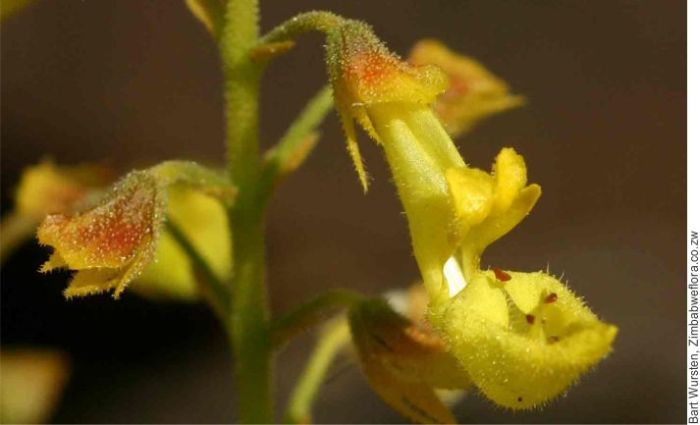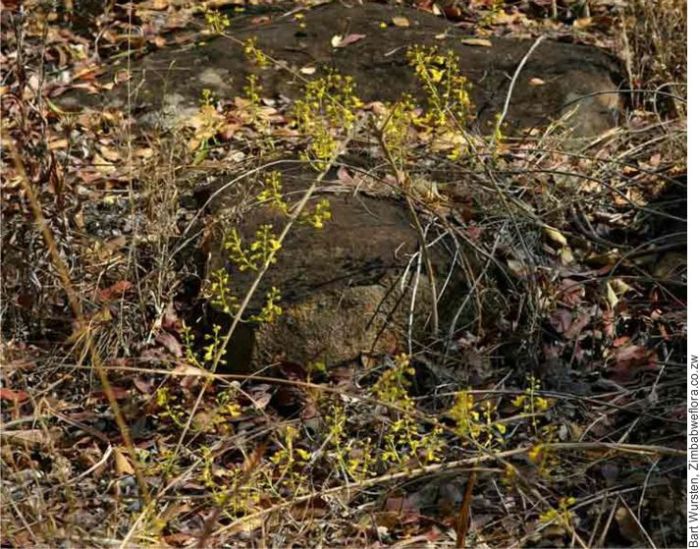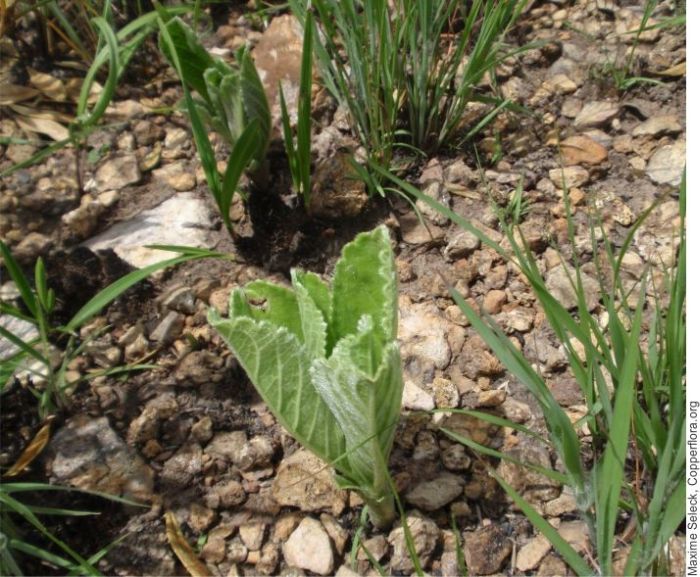Coleus esculentus
Coleus esculentus (N.E.Br.) G.Taylor (= Plectranthus esculentus N.E.Br.)
Family: Lamiaceae
Common names: wild potato, veld potato, African potato, Livingstone potato (Eng.); veldaartappel, wilde-aartappel (Afr.); itapile (Xhosa); tsenza (Shona); mutada (Venda); ujango, ujilo, umbondwe, umhlaza (Zulu), umbondiwe (Ndebele)
Introduction
The wild potato is a pleasant aromatic herb with prolific, beautiful, yellow flowers in winter and spring. It is able to withstand a variety of climatic and soil conditions and has edible tubers that are a great source of nutrition and can be used to make a variety of foods.

Description
Description
Coleus esculentus is an erect to trailing, semi-succulent, deciduous, aromatic herb or shrublet that grows 600–1 200 mm tall. It has tuberous roots that are fleshy and swollen, similar to the ordinary potato. They are characteristic of the plant. Several hairy stems, woody at the base, unbranched to slightly branched, arise from the tuberous roots.
Leaves are deciduous, 50–80 × 13–25 mm, oblong-elliptic, roughly hairy on both surfaces, glandular on the lower surface, the leaf margins toothed. The leaf base is obtuse or cuneate and the apex is obtuse.

Inflorescences are many-flowered, in axillary racemes, 50–80 mm long. Individual flowers are boat-shaped, pedicellate and solitary; the corolla is 14–16 mm long, yellow and expanding to the throat. The flowers only appear after the plant has shed its leaves. The calyx is 4–5 mm and elongates to 10 mm long after flowering has taken place. The fruits are small, ovoid, brown nutlets that are 1 mm long.
Flowering time is in winter and spring, after the leaves are shed, and it is the only species within the genus to flower in this season.
Conservation Status
Status
Coleus esculentus is assessed as DDD (Data Deficient - Insufficient Information) according to the Red List of South African plants. When a species is listed as DDD, it means that there is not enough information to make an accurate assessment of its conservation status.
This species was widely and commonly cultivated in the past. However, there has been a great decline in its cultivation, as it has been replaced by other domesticated crops, and in its natural habitat in the wild, it seems as if the species is exceptionally rare and its natural distribution and the extent of its range within South Africa are poorly known and understood.
It has been recently reported that a specimen of Coleus esculentus was discovered near Durban, but in threatened grasslands. There is not enough information to place Coleus esculentus into a threatened category. Material that was collected many years ago, did not indicate whether this plant was cultivated or obtained from the wild. Therefore, it is assumed, since there is a great decline in the plant population, that material was collected from cultivated specimens, rather than specimens collected in the wild.

Distribution and habitat
Distribution description
This species thrives in sandy, well-drained soils in rocky savanna, dry woodland and disturbed areas, where annual rainfall ranges between 700–1 000 mm, and where frost is minimal or completely absent. It is spread across the provinces of KwaZulu-Natal to Limpopo, as well into tropical Africa. In southern Africa, it is found in the wild in dry woodland areas, in forest margins, in areas of rocky hill-slopes as well as bushveld savanna.
In many countries, including Senegal, Zambia and Zimbabwe, wild potato is found in the wild, and it is cultivated or grown where there is a water source. In South Africa, in coastal areas such as KwaZulu-Natal, the Zulu speaking people have been cultivating or growing wild potato since prehistoric times. Many rural people in Mpumalanga and the Kuruman District situated in the Northern Cape, still make use of wild potato.
Derivation of name and historical aspects
History
The name Coleus is derived from the Greek koleos, meaning ‘a sheath’, and refers to the fused stamens of the type species for the genus, and a character that at one time was thought to be diagnostic for this genus. The specific epithet esculentus is a Latin word meaning ‘edible’ and this refers to its edible tubers.
This species was described and named Plectranthus esculentus by Nicholas Edward Brown in 1894, and this was done from plants that were collected and grown by John Medley Wood in the Durban Botanical Gardens. In 1934 this species was introduced by a gentleman called Mr Hepburn to Kirstenbosch National Botanical Garden from Nigerian stock (2832/34). Molecular studies on Plectranthus and closely related genera by Paton et al resulted in the revision of the genus in 2019 and the re-instatement of the genus Coleus. This species falls within the ‘coleus clade’ and is therefore renamed as Coleus esculentus.
Besides Coleus esculentus, there is only one other yellow-flowered species within this genus, namely C. tetragonus, but they are not likely to be confused as this species is an erect annual with stem bristles, glabrescent leaves and much smaller flowers.
Although commonly known as the wild potato, Coleus esculentus is not a member of the potato family, Solanaceae, to which the common potato belongs, but a member of the mint family, namely Lamiaceae. Coleus rotundifolius (formerly Solenostemon rotundufolius) from tropical Asia, is another wild potato with edible tubers that has been cultivated in South Africa since ancient times. It has rounded tubers and blue flowers.
Ecology
Ecology
Coleus esculentus is able to grow in a variety of warm climates, ranging from humid, such as in Equatorial Africa, to dry conditions, such as in the Northern Cape. It has good underground storage organs, namely roots that are fleshy and swollen, and like the ordinary potato, has true tubers (underground stems that are modified and where new shoots are able to arise). These enable the plant to survive a periods of dormancy when conditions for growth are not suitable.
The root tubers are a valuable source of food in Africa and an important nutritional food crop. The plants are able to thrive under diverse conditions, and in marginal soil and climatic conditions across the continent.
Coleus esculentus, as with many members of the genus, is largely unaffected by insects, pests or diseases. Caterpillars of various moth and butterfly species have been reported to eat the leaves, but they can be removed manually by hand. Although not greatly affected by these conditions, they are, however, affected by an attack of soil nematodes, and when grown for commercial use, measures need to be taken in order to control this.

Uses
Use
Wild potato is very popular as a source of food for indigenous people as it is the most nutritious tuber of all tuber vegetables and contains a high level of starch (80%). In addition to its high starch content, it contains 13% essential amino acids, which are essential to the body for constructing proteins, as well as other important vitamins and mineral elements, such as calcium, iron and vitamin A.
Wild potato tubers have been prepared and used like the common potato in Central Africa since ancient times, when it was introduced by people that migrated southwards from Central Africa. The use and cultivation of it in local or rural communities has declined since then, hence it is classified as one of southern Africa’s important ‘lost crops’!
The tubers are eaten like the common potato, and although they have a bland taste, there are varieties that are more pleasant and have the taste of mint. These tubers may be eaten raw, or the peels scraped off, then boiled, fried and even roasted. They are a delicacy in stews, soups and many other dishes.
It can be cultivated and grown throughout the year in tropical areas. The wild potato, as with most of the indigenous tubers, have been substituted with the more recently introduced crops: taro (Colocasia esculenta), commonly known in South Africa as amaDube, which is a species from Malaysia or India which dates back as far as about 2 000 years ago; the tropical sweet potato (Ipomoea batatas); and cassava (Manihot esculenta), the latter two both from South America, and both of which are largely grown and cultivated in Africa as staples.

Growing Coleus esculentus
Grow
With its display of showy and profuse yellow flowers in winter and spring, and its edible and nutritious tubers Coleus esculentus is an asset in any garden. It is easy to grow and thrives in many climates and soil conditions, with the exception of the winter-rainfall region of the Western Cape, and is best suited to warm, subtropical conditions. Grow it in full sun, in well-drained soil.
To plant the tubers, dig the soil to a depth of as least a full spade blade, remove stones which will interfere with tuber development, and break up clods of earth. Shape loose soil into ridges between half a metre and a metre apart, or in rows of mounds. Compost may be used, and in parts of Africa, it is customary to add some wood ash and even diluted cattle urine. Plant whole tubers or tubers cut into small sections 5–10 cm deep in the ridges or mounds, which should be separated by a spade blade from each other, 25–30 cm (Xaba & Croeser 2011). A single cluster of tubers from one plant, can produce about 100 new plants, by being cut into comparatively small sections. Planting tubers takes place with the onset of the early spring rains, at the end of August to early September in summer-rainfall areas of South Africa (Xaba & Croeser 2011). It can also be propagated from stem cuttings.
Although the wild potato is adapted to relatively high rainfall conditions, it can survive drought. Rainfall of 750 mm (or with watering to make up a shortfall) is preferred. Well-drained, sandy soils are preferred, as clay soils produce irregular tubers because of water-logging. It can be planted in clearings either as a sole crop, or grown together with a low-growing crop. Soil must continue to be heaped up around the plant to stimulate tuber production and to prevent exposed tubers going green and starting to sprout. Surface cultivation by hoe to remove weeds is usually done before the first month is up and then again a month later. Some varieties do grow in heavier soil near marshes and these areas are used in Zambia, Zimbabwe and Senegal during the dry season. In South Africa it grows in dry to subtropical bushveld (savanna) regions, but is often found on rocky hill slopes (Xaba & Croeser 2011).
Harvesting and storage of tubers: Either the whole plant with the tubers attached is removed, or the earth can be gently moved away and the mature tubers detached, leaving the main plant to continue growing. If the whole plant is removed, then a tuber should be left in place to rest in the soil and grow in the next rainy season. The tubers can be harvested 4 to 6 months after planting, depending on rainfall, soil and situation. The tubers are eaten fresh but can be stored in baskets in the shade or layered in dry sand for later use. They have a relatively short shelf life, however, and are vulnerable to damage, so must be handled carefully (Xaba & Croeser 2011).
References
- Crouch, N.R. & Styles, D.G.A. 2010. Rediscovery in South Africa of the neglected African vegetable Plectranthus esculentus. Bothalia 40 (1): 65–68.
- Fox, F.W. & Norwood Young, E. 1982. Food from the veld: edible wild plants of southern Africa. Delta Books, Cape Town.
- Hyde, M.A., Wursten, B.T. & Coates Palgrave, M. 2020. Flora of Zimbabwe: Plectranthus esculentus. https://www.zimbabweflora.co.zw/speciesdata/species.php?species_id=149820
- Jackson, W.P.U. 1990. Origins and meanings of names of South African plant genera. University of Cape Town.
- Mapfumo, T. undated. The Livingstone Potato. Ndeipi. http://ndeipi.co.zw/author/lucy/page/7/
- Paton, A.J., Mwanyambo, M., Govaerts, R.H.A., Smitha, K., Suddee, S., Phillipson, P.B., Wilson, T.C., Forster, P. I. & Culham, A. 2019. Coleus and Plectranthus (Lamiaceae): a tale of more than two genera. Phytokeys 129: 1–158. http:// Phytoes.pensoft.net.
- Pooley, E. 1998. A field guide to wild flowers Kwazulu-Natal and the eastern region. Natal Flora Publications Trust, Durban.
- Van Jaarsveld, E. 1987. The Plectranthus handbook. National Botanical Gardens, Cape Town.
- Van Jaarsveld, E. 2006. The southern African Plectranthus and the art of turning shade to glade. Fernwood Press, Vlaeberg, Cape Town.
- von Staden, L. & Styles, D. 2011. Plectranthus esculentus N.E.Br. National Assessment: Red List of South African Plants version 2020.1. Accessed on 2020/06/06
- Xaba, P. & Croeser, P. 2011. Wild potato. Veld & Flora: 17, December.
Credits
Bronwynne Busch
National Herbarium, Pretoria
July 2015,
updated by Alice Notten
Kirstenbosch National Botanical Garden
June 2020
Plant Attributes:
Plant Type: Perennial
SA Distribution: KwaZulu-Natal, Limpopo, Mpumalanga
Soil type: Sandy, Loam
Flowering season: Spring, Winter
PH:
Flower colour: Yellow
Aspect: Full Sun
Gardening skill: Average
Special Features:
Horticultural zones








Rate this article
Article well written and informative
Rate this plant
Is this an interesting plant?
Login to add your Comment
Back to topNot registered yet? Click here to register.